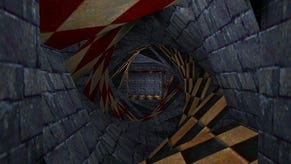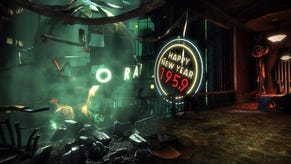Ed blog: BioShock 2 MP three-way!
The full interview transcript.
Are you ready to go behind the curtain again? Having previewed and interviewed the BioShock 2 team about the single-player earlier this year, this week I got to speak to them again about the new online multiplayer component developed by Digital Extremes.
Rather than flying back to Marin though, or up to DE's offices in Toronto, 2K and Eurogamer harnessed the magic of international video conferencing to receive a presentation consisting of a local video feed of the game in high definition, a boxout on the same massive plasma screen showing lead multiplayer designer Mathieu Bérube and lead producer at Digital Extremes Leslie Milner, and another boxout of 2K Marin's Melissa Miller in the States. All I had to do was go to Windsor.
Once we'd gone through the section of the game 2K is showing at this stage, I was able to chat to Bérube, Milner and Miller about it, and rather than dump all the quotes I didn't use in the preview, I thought I'd recycle the transcript using our own magical Editor's blog. Read on to learn more about the multiplayer mode's origins, how it's being developed, what it's like, and why I'm still incompetent.
We're heading there! Yes!
Oh no no, we always knew.
It started with basically with 2K asked for our help on the PS3 port, before we even heard the idea of trying the multiplayer angle, but as soon as we heard it was really a no-brainer - there was nothing out there like BioShock multiplayer.
All the shooters out there are mostly military, they are really fun, but none of them touch on the whole combinatorial play, the unique environment, using all those player tools together to really formulate a really personalised play style and bring that against other players. And looking at the narrative it was such a no-brainer to go back to the civil war because everybody was out for themselves during that time in Rapture. Every piece of the puzzle quickly fell into place.
A thing a lot of people don't realise is that in BioShock 1 the splicers that you battled were actually supposed to have plasmid powers, and that fell by the wayside in terms of conveying that to the player - the only ones that were left over from that were the ceiling crawlers and the Houdini splicers.
If you think about it, all the other splicers were messed up and everything, but they're not displaying any unusual powers like you get, so one of the things we were really excited about exploring in a multiplayer component was this idea of... we're giving you all this cool s*** to do, what happens when everyone else around you can do the same cool s*** and how do those things make new gameplay experiences?
Obviously we're not prepared to reveal everything about the narrative today. What we can say is that as you rank up you're going to get communications from Sinclair Solutions more and more, and they're going to touch on what's happening in Rapture. They will talk about things you may or may not have heard in the first BioShock, so there's a real incentive, a real motivation for us to really touch on that here before the first game and delve more into it.
I think something that's important is that when you think about multiplayer, the narrative a lot of times comes from the experience that you create yourself in the match, and that's really what we're offering in addition to the things that Mathieu was touching on - the messages and giving you the spark of the civil war - is that you are going in and you are becoming part of that history and contributing to Rapture's destruction.
We have a creative director for BioShock 2 for the entire product - Jordan Thomas - and so he's really driving the vision and holding keys to the narrative across the whole game. It's working with him and making sure that the things we come up with fit into the Rapture universe as well as getting guidance from him on what is interesting about the BioShock narrative that we can touch on in multiplayer.
We work really closely together - 2K and DE - so we're always bouncing ideas off of one another. The leads work really closely together. Mathieu's involved in it all the time, Jordan's involved in it all the time, Melissa and I work really closely, so it's a great working relationship in that regard.
We even have people flying over there to work for a couple of weeks and the same for them coming over here, so it's a really close partnership.
The single-player is set 10 years later, and you're playing as a prototype Big Daddy, so all of his weapons are one-handed. We do touch on a bit of the same points, like obviously we both have fire, electro-bolt and ice, but both the single and the multi have their own unique plasmids as well.
Oh of course, yes.
We touched a bit at the end of the video on the power dash plasmid, which allows you to fly in a straight line really fast, so you can use that to traverse gaps or to tackle somebody or to evade combat really quickly, so it's a really useful plasmid that is not really found in single-player but fits multiplayer really well.
Another is the geyser trap, which is similar to the cyclone trap of the first game, but it's water-based and you can use it yourself now, so think of it as a personal jump pad. You lay it on the ground and if you step on it you're going to be propelled upwards, so that big room in Kashmir you saw? With the geyser you can get to the second floor really fast. You can actually land geyser on somebody and propel him in the air.
Basically we track pretty much every positive action you do in a match and we tally it with ADAM rewards, which is our version of experience points. So kills, assists, taking down a Big Daddy... things we can't talk about! All of those things you do in a match contribute to your ADAM so you don't just have to win. You can just rank up at your own pace by competing in matches, and eventually you'll unlock more stuff to get better and discover your real play style.
We have 20 ranks. They're kind of divided into these loose clubs to get a nice fiction with the Sinclair Solutions programme. So at first you go into the Bronze Club, the Silver Society, then we tease you to get into the Gold Club - it's just fiction to kind of push you to get to the next club. We have incremental ranks between those with rewards at each rank.
Yep, when you rank up you can go back to your apartment and this is where you're going to get the nice message from Sinclair which may or may not touch on the back-story of Rapture. If you choose to invest yourself in the narrative you can go back to the apartment, but we never force you to. Just like the audio logs in the first game, if you don't care about the story you can ignore it. Same angle.
We have three game modes - deathmatch, team deathmatch and another team mode we can't reveal just today.
I'm very interested. I can't say anything though!
What you saw there was Kashmir restaurant. From the first game Kashmir was really small, really private, so this is our re-envisioning of it, much bigger, new rooms, a big ballroom that wasn't there. So that's the approach we're taking with pretty much all of our levels. Taking iconic locations from the first game and expanding on them. Rebuilding them from scratch basically with multiplayer in mind.
We try to vary them in different ways so that you do have different play styles that come out of the levels and that the levels serve different purposes as well, so some will be more vertical while others will be bigger spaces, some will be smaller.
In the video at the end, you may have caught a glimpse of Mercury Suites. In the first game Mercury Suites was really dank, claustrophobic, dark. In BioShock 2 multiplayer it's brightly lit, lush vegetation - so it received a big facelift by going back a year in the past. You also saw Point Prometheus which is the museum from the first game, but it's completely different - it's creatures of the sea now, you're fighting on an octopus!
And that's something that's important to note that has been neat for us. Since we are in Rapture's history at the beginning and during the fall, we've been able to take these iconic locations and explore what they would have been like before they became destroyed and decayed and the sea started to reclaim them.
It's a much-used point, but Mercury Suites... you walk in and there's trees, there's ivy, it's really beautiful, and you're like, 'I would totally want to live here!' And then with Point Prometheus, something that was kind of cool for our guys at the leads level, especially the BioShock veterans, was they were able to look at certain locations and say, 'You know what? We didn't like that! We thought we totally could have done a better job with this area. You guys should totally explore new ideas.'
And so Point Prometheus is a perfect example of that, because in BioShock 1 it's the gauntlet level and it's more of a natural history museum, and why would there be a natural history museum in Rapture? There should be a museum, but people should be trying to make money off it, and so it became this more PT Barnum sensationalised trying-to-make-a-buck place. While having familiar locations, we wanted to offer something new to the BioShock audience.
In some cases. In other cases, it was an opportunity for these guys to take a cool place in Rapture and build an entirely new map from scratch, and that's something else... If there's anything brought over from BioShock 1, it's been rebuilt from scratch for multiplayer. We understand: there is a difference between multiplayer and single-player expectation and that is something we have been extremely conscious of. Like the maps - all of those are built from scratch with a multiplayer audience in mind.
And the same thing - hey, I hear our guns were not the best thing ever for a first-person shooter in BioShock 1, so making sure that we were addressing that and they were even better for a multiplayer audience.
I would say yes. I don't play Call of Duty, I don't want to speak for anybody who likes that game - maybe Mathieu can talk about that more - but one of the things about BioShock 1 is that it offered just so many different choices in terms of how you played the game. There are people who came in and came away and they were like [puts on a voice and flaps arms], 'Oh my god! The story's the most amazing thing ever! I've never seen a story like this! It's amazing' and other people were like, 'What story? I was just totally f***ing around with plasmids', and some people just run and gun their way.
Attracting all these people who had so many different experiences... yeah, I think that the expectations are very different from a fan of BioShock 1 to, say, a Call of Duty going in, having a really amazing multiplayer experience.
Well, I mean, I can't talk about Call of Duty - that's another game, and hey it's an awesome game, but you know, I'm going to pretend to dissect that or anything like that--
It's both really. It's making sure that BioShock 1 fans, even if they're more single-player focused, have an accessible multiplayer mode they can start to dip their toes in. Okay, an example of this is: I suck at first-person shooters, but I love playing BioShock because there are so many different options for me that I can still have a cool gameplay experience even though my accuracy sucks, and so making sure that we retain that in a multiplayer format is super important.
So I can go into multiplayer, and I suck. I played the Halo 3 beta - I played for five minutes, got killed a zillion times, and was like, 'I'm never touching this again', but I go in and play BioShock 2 multiplayer, and after a couple of matches I'm holding my own. I'm like in the middle of the race, and that feels good to me, and that makes me want to keep playing and experimenting.
But at the same time, there are people out there who, when they buy their games, want to make sure that there's a multiplayer component, and they have expectations, and we want to make sure that we are a comparable, competitive multiplayer game in that respect.
To go back to the point about Call of Duty and how we differentiate, I'm a big, big Call of Duty fan - I can't wait for Modern Warfare 2. I think every great game finds its own audience, and I'm hoping there's going to be a big audience that jumps between both games, because they feel very, very, very different. Like Mel says, it's very accessible for single-player oriented gamers to jump into multiplayer and hold their own, and discover their own play style, which is really great.
I think that's something we were really focusing on from the beginning - making this as accessible as possible for those single-player fans to easily jump into multiplayer and feel they can hold their own and want to continue playing. And then there's also an additional level on top so hardcore gamers can play on and be challenged and enjoy the game just as much.
So this is a game for BioShock fans and for multiplayer fans - it's double edged!
The amount of tools at your disposal to score points in offence is really high. Leading an attack with a plasmid augments your chance of success a lot in enemy encounters. Mel, you wanna?
It really is - it's the variety of the toolset. From the video, one of the first kills that you saw was using the one-two punch established in Bio 1. I zap a guy and they're stunned, and I have a few milliseconds to get my gun and get a good shot off. And then things like incinerate which does damage over time. I remember I was playing one match and I had a little area that I was holding down, I had very distinct entries that I was guarding, and I would see people go by and I'd tag them with incinerate. If they were low on health I'd get the kill.
And if not, you'd get an assist!
And then turrets. Turrets are another f***ing great example of this, where I remember we were testing the game one weekend and I kept just going to one turret. As soon as I got in, I'd hack that turret and that became my little battle zone, and every time people came in... At one point I got a four-kill streak between the turret and myself, and everyone was like 'what the hell?' After that, every game, everyone went straight for that turret to try and destroy it before I got it. There are just so many different options and ways you can express yourself.
We're not actually discussing any concrete DLC plans at this time, but obviously from the original BioShock releases you can tell that we do understand the importance of DLC to a game, and especially with the PS3 with Challenge Rooms, and how it can offer new experiences from the main game. So it's definitely something that we are thinking about carefully.
Well, you haven't asked, so I might as well say - there's a Little Sister in there, but we're not prepared to say exactly why.
[Laughs]









